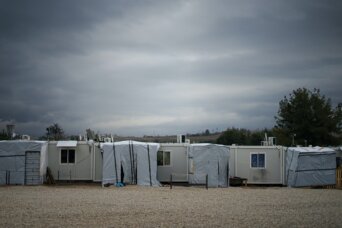- About
- Topics
- Story
- In-Depth
- Picks
- Opinion
- News
- Donate
- Signup for our newsletterOur Editors' Best Picks.Send
Read, Debate: Engage.
| topic: | Refugees and Asylum |
|---|---|
| located: | Poland, Belarus |
| editor: | Katarzyna Rybarczyk |
Faced with a steel wall on one side and inhumane treatment on the other, refugees are stuck in limbo at the Poland-Belarus border, holding onto the faint hope that Poland will let them in. But as winter is well under way and temperatures regularly fall below freezing, this wait can be dangerous.
It has been one year since Belarusian President Alexander Lukashenko orchestrated a migrant crisis to destabilise the EU in retaliation for the sanctions imposed on his country. Although the numbers are lower now, every week hundreds of migrants still attempt to cross the border into Poland. A report published by NGO Grupa Granica revealed that between 1 October and 30 November 1,104 people asked for humanitarian assistance at the border.
Unlike refugees coming from Ukraine - for whom there is an open-door policy - arrivals from the Middle East and elsewhere are offered very little assistance. Poland continues to ignore their asylum claims, making them wait for days, often weeks. With nowhere to go, they have no choice but to camp in forests without tents or any other protection from snow and rain.
Prolonged exposure to extreme cold puts migrants at risk of hypothermia, as well as traumas to feet that can lead to amputations. Dominik Domański, a Polish anesthesiologist, said that “those with symptoms of type II hypothermia [which is when hypothermia causes impaired consciousness] should be hospitalised. Leaving them without medical assistance can lead to worsening their condition and death.” And yet, the Helsinki Foundation for Human Rights reported that Poland has been conducting illegal pushbacks without assessing migrants’ medical conditions.
Until July 2022, the Polish government maintained a state of emergency and turned the border area into a highly militarised no-go zone, banning all organisations and individuals from providing support to migrants. On the day that the state of emergency ended, the Polish government announced the completion of a 5.5-metre tall wall covering 186 kilometres of the border with Belarus. The barrier’s primary purpose is to deter refugees, but at the same time, it makes it difficult for humanitarian actors to reach those in need.
Since the state of emergency has been lifted, some local groups have returned to the region and provide migrants with direct assistance, offering them food and warm clothes. Nevertheless, refugees’ access to urgently-needed medical care remains limited.
Médecins Sans Frontières (MSF), for example, decided to withdraw its team from the border after “being repeatedly blocked by Polish authorities from accessing the forested border region, where groups of people are surviving in sub-zero temperatures, in desperate need of medical and humanitarian assistance,” the organisation stated in a press release.
The situation is critical because as temperatures continue to drop, the number of people dealing with health issues is likely to increase. Luckily, despite the difficulties in reaching the refugees trapped at the border, INTERSOS, a non-profit humanitarian aid organisation, recently launched a medical assistance project for those trying to cross into Poland from Belarus. INTERSOS rightly pointed out that the “presence of independent organisations and activist groups providing medical assistance at the border can be a matter of life and death.”
Refugees at the Poland-Belarus border have found themselves caught in the middle of a hybrid war between Belarus and the EU. To prevent people from dying as a result of being used as a bargaining chip, more international organisations specialising in healthcare assistance should get involved in helping refugees there, especially as temperatures will remain low for several months to come.
